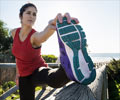Although warm, sunny days motivate you to throw on the nearest pair of sneakers and head outdoors for a run, choose your running shoes wisely to prevent common running injuries.

‘Running in shoes that don’t fit properly can lead to or exacerbate medical problems such as shin splints, stress fractures, plantar fasciitis, irritated nerves or the loss of a toenail.
’





Each time a foot hits the ground during a run, it experiences a force equivalent to three times the person’s weight, she explained. “Proper footwear is critical for making sure the feet can handle all that force without pain or damage,” she said. Running in shoes that don’t fit properly or don’t match a runner’s foot type or running style can lead to or exacerbate medical issues such as shin splints, plantar fasciitis, stress fractures, irritated nerves or the loss of a toenail. Rowe-Bauer suggests considering three primary factors when choosing running shoes:
- Foot type. Human feet are either high-arched, flat or neutral, depending on how much of the inner arch touches the ground during a stride.
- Running style. Some runners strike the ground first with the heel and roll through to push off the toes to their next stride. “Toe runners” strike first with the forefoot and push immediately into the next stride.
- Terrain. Feet respond differently to running on different surfaces, from treadmills to asphalt to dirt trails. Tread and cushioning should be appropriate for the surface.
She said that anyone new to the sport of running — or experienced runners who have foot or leg pain — should start with a doctor’s exam to determine general health, foot type, and running style.
“Bring old athletic shoes; the wear patterns can give the doctor clues about things like foot overpronation (rolling inward) or supination (rolling outward),” Rowe-Bauer said. “Be honest about any pain experienced during or after running.”
Try-on tips
Advertisement
- Buy shoes in-person at a store, preferably one with knowledgeable salespeople who encourage trial runs, literally, in the shoes at or outside the store before purchasing.
- Shop for shoes in the late afternoon because feet swell as the day progresses (and as a run progresses).
- When trying on shoes, wear socks that will be worn while running.
- Choose shoes that fit well, regardless of what size they are. A person’s feet change in size over the years, and shoe sizes vary by brand and even by model within the same brand.
- Select shoes with a wide toe box, so toes are not constricted during running.
Once the best pair of shoes have been found, consider buying a spare to be prepared when the first pair wears out.
Advertisement
For the average runner putting in around 15 miles a week, replacing shoes every six months is probably sufficient. Rowe-Bauer says that even if the tread on the sole of the shoe is not too worn, the cushioning and support inside the shoe probably have deteriorated by that time.
Socks and inserts
In addition to shoes, two other types of footwear are important for runners. Everyone should wear socks when running.
“Socks — especially those made with synthetic fibers — provide extra cushioning and wick away sweat to help prevent blisters, chafing and fungus,” Rowe-Bauer said.
“This is especially important for diabetic runners, who should check their feet every day so that small abrasions do not turn into major problems.”
Your primary care provider might also recommend a custom-made or over-the-counter orthotic shoe insert for the proper individualized support. Expert advice is essential for anyone considering orthotics since the wrong insert can cause foot problems instead of relieving them.
“From socks and inserts to running shoes, choose the footwear that meets individual needs, and enjoy safe running outdoors all the way into autumn.
Source-Newswise













